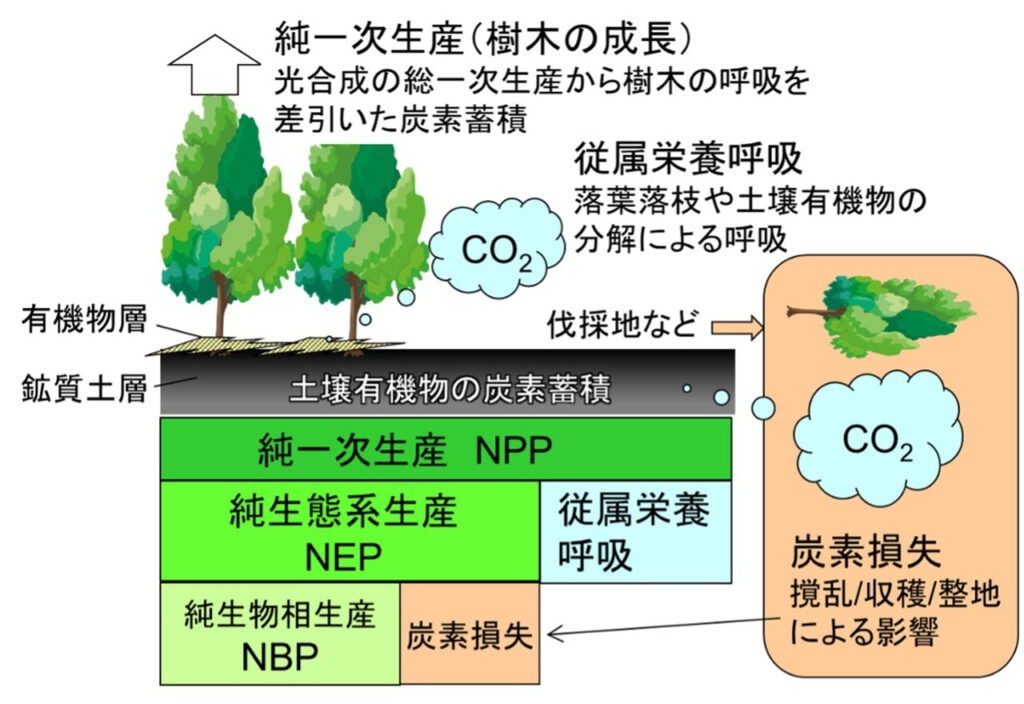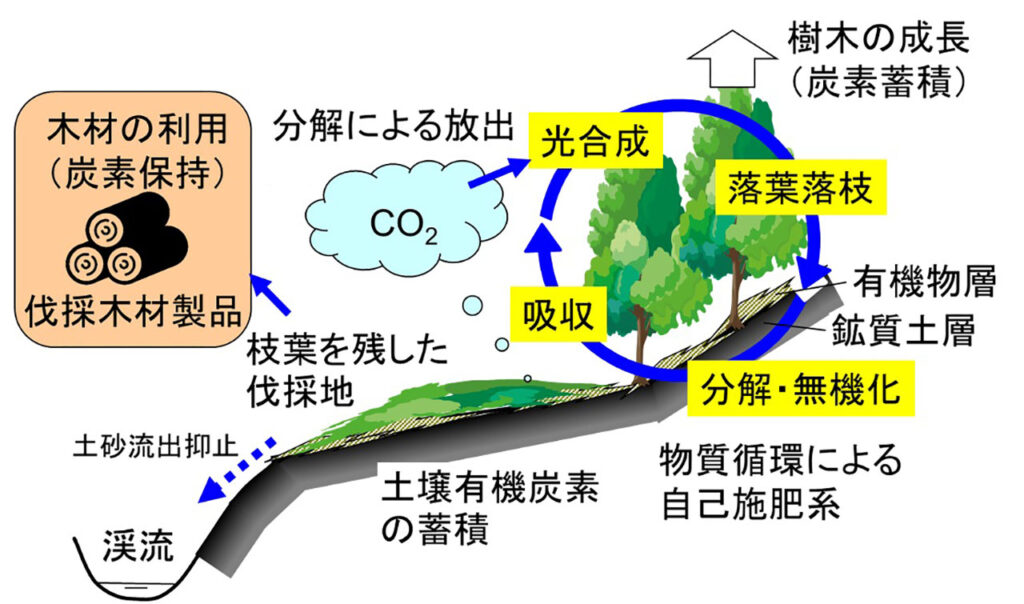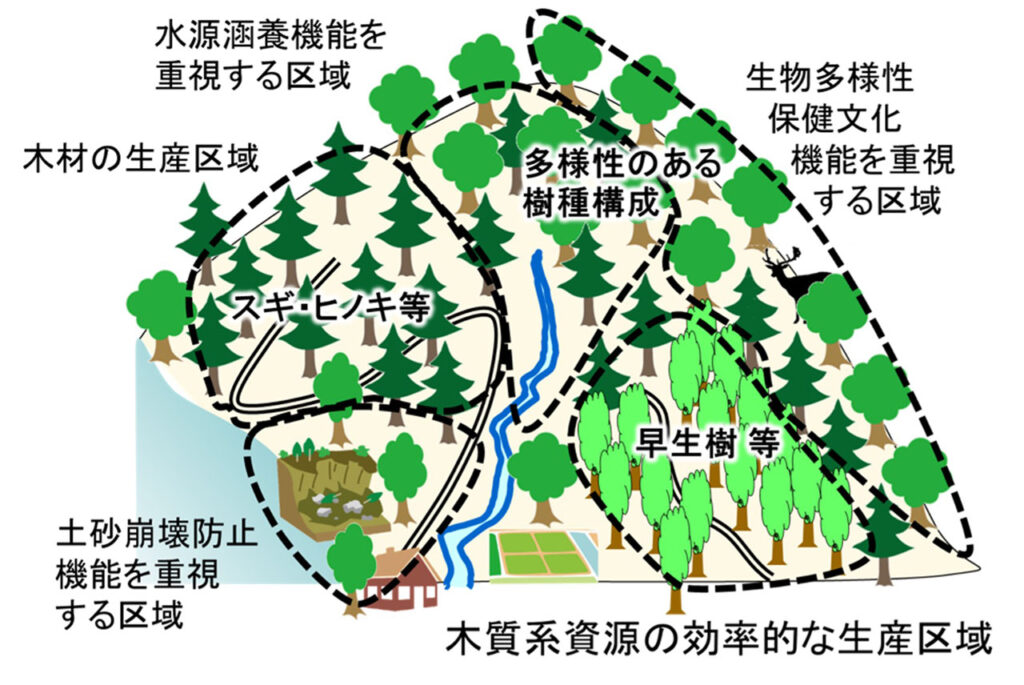Achieving carbon neutrality through fast-growing forestry
Updated by Hiroto Toda on July 01, 2025, 5:18 PM JST
Hiroto TODA
Graduate School of Tokyo University of Agriculture and Technology
Professor, Graduate School of Agriculture, Tokyo University of Agriculture and Technology Publications: Practical Guide to Forestry and Forestry, Second Edition, Revised Edition (co-authored, Asakura Shoten, 2024), Forest Balance (co-authored, Tokai University Press, 2012), etc.
Click here to read the previous article.
New Forestry Potential Opened Up by Biomass-Producing, Highly Efficient Fast-growing Trees [Cultivating the Future through Carbon Cultivation].
Early maturing trees are expected to regain carbon stocks in a short period of time after harvesting and reforestation. The trunk is the main source of carbon accumulation in trees, and the higher the stand density and trunk volume per unit area, the more effective the tree species is, and the higher the specific gravity of the xylem, the higher the carbon storage capacity.
In forest ecosystems, however, forest soils accumulate more carbon than trees. In forest ecosystems, dead organic matter such as fallen leaves and branches is decomposed into soil organic matter by soil animals and microorganisms. Soil organic matter includes a wide variety of materials with different decomposition rates (residence times), some of which are easily decomposed by microorganisms and release carbon as CO2, while others are more difficult to decompose and remain in the soil for several centuries.
The Paris Agreement uses Net Primary Production (NPP), which is the net primary production of trees and other plants, minus CO2 and other emissions from the decomposition of fallen leaves and branches, dead trees, and organic matter in the soil, as the basis for calculating increases and decreases in carbon stocks in forest ecosystems. Ecosystem Production (NEP) is used as the standard. In addition, Net Biome Production (NBP), which is the net carbon loss due to fires and other disturbances, harvesting, and land clearing during land use change, is subtracted from NEP when calculating the net carbon accumulation due to land use change such as deforestation (Figure 1).

In forests, logging provides fresh organic matter, such as branches and leaves, to the ground surface, and the loss of the tree canopy can affect the carbon dynamics in forest soils, such as the increase in temperature caused by direct sunlight. Thus, it is important to understand the dynamics of soil organic carbon in sites and soils that have been converted to fast-growing tree species (Figure 2).

The effective use of cedar and cypress from the early-growing forestation areas as well as harvested wood products such as wooden buildings and furniture will maintain their carbon fixation content and delay CO2 emissions to the atmosphere, rather than burning them immediately for energy use.
However, even with the addition of carbon fixation from harvested wood products, the recovery of NBP reduced by logging takes time, even for fast-growing trees. For example, from the short-term perspective of forests and forestry, such as achieving carbon neutrality by 2050, logging and renewal of forests are calculated to have a negative impact on the reduction of atmospheric CO2 concentration.
However, it is important to establish a long-term sustainable resource supply system by implementing fast-growing forestry in appropriate locations, where wood-based resources can be produced and harvested repeatedly in a short period of time to replace fossil resources. As mentioned above, this will also lead to the conservation of tropical forests, which are a treasure trove of biodiversity, as well as old-growth and natural forests around the world.
It is necessary to select a site suitable for the growth and utilization of newly introduced fast-growing trees, and to examine the sustainability of the site in terms of material cycle indicators. Since forests are maintained by a self-fertilizing system based on the nutrient cycle of the forest ecosystem, forestry does not normally supplement nutrients with fertilizers as in agriculture, except when planting trees, and forest fertilization is not realistic from the standpoint of labor and cost (Figure 2).
Therefore, it is important for the sustainability of forestry to conserve the soil, which is the foundation of forest productivity, to maintain proper material cycles, and to control nutrient runoff (loss) outside the forest ecosystem. Since early maturing trees must be harvested in a short harvest season, it is important to evaluate the material cycle from the viewpoint of whether or not early maturing tree plantations cause soil erosion due to a decrease in forest floor coverage (the coverage of the ground surface by the forest floor vegetation and the deciduous layer) and whether or not they cause a decline in soil fertility due to severe nutrient deprivation.
Nutrient supply from nitrogen-fixing plants such as legumes is said to be important for their sustainability because tropical forest soils are low in nutrients, and fast-growing tree production is supported by nutrient cycling rates such as deciduous leaf fall, and whole-tree collection, which removes branches and leaves along with the trunk, has a high nutrient yield (Agus et al., 2004). On the other hand, fast-growing eucalypts and acacias have been reported to grow to the same extent with less phosphorus and have higher nutrient use efficiency than other tree species (Inagaki & Tange, 2014).
Therefore, in growing fast-growing trees in relatively fertile sites in Japan, if only trunks are collected, leaving nutrient-rich branches and leaves in the forest area (Toda, 2004), soil erosion and nutrient deprivation will be suppressed and rapid land degradation will be unlikely to occur.
As mentioned above, Japan's planted forests have reached the stage of harvesting, and forest management is required that contributes to the prevention of global warming by promoting the use of woody resources while maintaining their functions for the public good, such as mountain disaster prevention and water source recharge. Large-area clear cutting that covers the entire watershed should be avoided, as it may cause rapid decomposition of soil organic matter, resulting in the release of CO2 and large amounts of materials into the stream. Riparian forests are particularly vulnerable to material runoff, and careful management with minimal disturbance is essential.
On the other hand, if we consider the introduction of short harvesting with fast-growing trees, we can maintain a good balance between the use of woody resources and the ability to fix carbon and retain nutrients through vigorous tree growth and nutrient absorption, and also maintain and promote the public benefit function. The public interest function will also be maintained and enhanced.
Watershed management is required to optimize forest management through simulations based on past and future research and studies to determine whether forest management methods, including the introduction of fast-growing forestry, are appropriate in light of the forest's public benefits (Fig. 3).

For this purpose, the perspectives of not only natural science but also social systems and consensus building are indispensable, and the development of research on ecosystem management through multidisciplinary collaboration is expected (Toda, 2022). (Hiroto Toda, Professor, Graduate School of Agriculture, Tokyo University of Agriculture and Technology, Department of Natural Environment Conservation)
■References
Agus, C., Karyanoto, O., Kita, S., Haibara, K., Toda, H., Hardiwinoto, S., Supriyo, H., Na'iem, M., Wardana, W., Sipayung, M.S., Khomasatun and Wijoyo, S. (2004) Sustainable site productivity and nutrient management in a short rotation plantation of Gmelina arborea in East Kalimantan, Indonesia. New Forest28: 277-285
FAO (2020) Global Forest Resources Assessment 2020: Main report. Rome. 165pp.
Inagaki, M. and Tange, T. (2014) Nutrient accumulation in the aboveground biomass of planted tropical trees: a meta-analysis. Soil Science and Plant Nutrition 60: 598-608.
Iwasaki, M., Saka, S., Fujima, G., Hayashi, T., Matsumura, J., Murata, K. (eds.) (2012) Fast-growing trees. Industrial Afforestation and its Utilization, KAISEISHA. 259pp.
Toda H (2004) Effects of harvesting and whole-tree collection of forest residues on material cycles in forest ecosystems. Forest Science 40: 33-38.
Toda H. (2022) Sustainable forest utilization and water source recharge function. Trends in Science 27(1): 40-44.